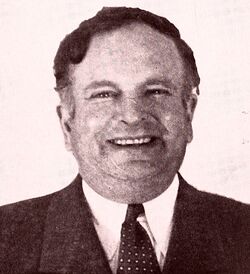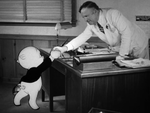Leon Schlesinger
- You may also be looking for Leon Schlesinger (character).
| Leon Schlesinger | |
|---|---|
 | |
| Born | May 20, 1884 Philadelphia, Pennsylvania |
| Died | December 25, 1949 Los Angeles, California |
| Cause of death | Viral infection |
| Nationality | American |
| Occupation(s) | Film producer |
Leon Schlesinger (May 20, 1884 – December 25, 1949)[1] was an American film producer who founded Leon Schlesinger Productions, later known as Warner Bros. Cartoons. He was a distant relative of the Warner Brothers, and as head of his own studio, served as the producer of the Looney Tunes and Merrie Melodies theatrical cartoons from 1930 to 1944.
Schlesinger died of a viral infection on Christmas Day of 1949, at the age of 65.
Biography
Early life
Schlesinger was born to a Jewish family in Philadelphia, Pennsylvania, on May 20, 1884.
After Schlesinger went through several jobs at a theater as an usher, songbook agent, actor, and manager (including the Place Theater in Buffalo, New York)[2] he moved to Hollywood and founded Pacific Title & Art Studio in 1919, where most of his business was producing title cards for silent films. As sound films (or "talkies") replaced them by the end of the 1920s, Schlesinger looked for ways to capitalize on the new technology and stay in business. Some film historians claim that he helped finance the Warner Brothers' first talkie, The Jazz Singer, in 1927.[3][4] He then secured a contract with the studio to produce its then-new Looney Tunes series, and signed animators Hugh Harman and Rudolf Ising to create these cartoons with their character, Bosko, as their star.
Career
Schlesinger was a shrewd businessman with a keen eye for talent. When Harman and Ising left Warner Bros. in 1933, as a result of numerous budget disputes, Schlesinger set up his own animation studio on the Warner Bros. Sunset Boulevard lot at the corner of Van Ness and Fernwood. He pursued animators away from the studio, including some who had departed from Harman and Ising like Bob Clampett. One of them was Friz Freleng, whom Schlesinger promoted to oversee the production of Looney Tunes and to develop its sister series, Merrie Melodies. Freleng's blooming talent, along with Schlesinger's hiring of Robert McKimson, Tex Avery, Chuck Jones, and Frank Tashlin further increased the quality of the studio's output. He later added composer Carl Stalling and voice actor Mel Blanc, and collectively these men created many famous characters as Porky Pig, Daffy Duck, and the most popular of them all: Bugs Bunny. Schlesinger, as a buisnessman, mainly took on a "hands off" approach to the animation unit. He allowed his directors to have freedom to create what they wished, providing that the resulting films were successful. Schlesinger sold Pacific Title & Art Studio in 1935 to concentrate on his animation studio.
Despite giving his animators creative control for the cartoons, Schlesinger was known for his straightlaced business practices. His animators worked in a run-down, decaying studio (with Avery's unit being a ransacked bungalow they dubbed "Termite Terrace"), and Schlesinger briefly shut down the studio in mid-1941 when unionized employees demanded a pay raise. On another occasion, he boycotted the Academy Awards for what he claimed was preferential treatment for the Walt Disney Cartoon Studio.
Schlesinger was also know among animators for his lisp. One repeated story states that Mel Blanc patterned the voices of both Daffy and Sylvester the Cat on Schlesinger. However, in Mel Blanc's autobiography That's Not All Folks!, Blanc contradicts that conventional belief, writing, "It seemed to me that such an extended mandible would hinder his speech, particularly on words containing an s sound. Thus 'despicable' became 'desthpicable'."[5]
Later life
Schlesinger remained as head of the animation studio until 1944, when he sold his assets and copyrights of the Looney Tunes cartoons to Warner Bros. Edward Selzer assumed his position as producer. Although he retired from being head, he continued to market the characters and headed Warners' Theater Services until his death in 1949.
Appearances and tributes

Leon Schlesinger appeared as himself in Friz Freling's short, You Ought to Be in Pictures (1940), which combined live action with animation. Mel Blanc voiced Daffy, Porky, and all of the other characters, except for Schlesinger, who dubbed his voice because the studio didn't have a sound camera. As with the other Warner cartoon staffers, Schlesinger's likeness was used as a caricature in such cartoons as Hollywood Steps Out (1941), Russian Rhapsody (1944) and Nutty News (1942).
Schlesinger's name was used for the Schlesinger Gym, in the 1996 feature film Space Jam.
Credits
References
- ↑ Ellenberger, Allan R. (May 1, 2001). Celebrities in Los Angeles Cemeteries: A Directory. McFarland. ISBN 978-0-7864-5019-0.
- ↑ The Buffalo News, April 15, 1944
- ↑ Sito, Tom (2006). Drawing the Line; page 40. ISBN 9780813171487.
- ↑ Furniss, Maureen (2005). Chuck Jones Conversations; page 24. ISBN 9781578067299.
- ↑ Blanc, Mel; Bashe, Philip (1989). That's Not All, Folks!. Clayton South, VIC, Australia: Warner Books. ISBN 0-446-51244-3.